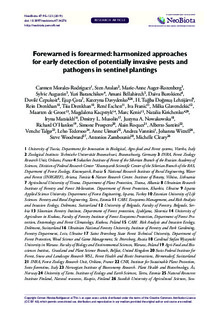| dc.contributor.author | Morales-Rodríguez, Carmen | |
| dc.contributor.author | Anslan, Sten | |
| dc.contributor.author | Auger-Rozenberg, Marie-Anne | |
| dc.contributor.author | Augustin, Sylvie | |
| dc.contributor.author | Baranchikov, Yuri | |
| dc.contributor.author | Bellahirech, Amani | |
| dc.contributor.author | Burokienė, Daiva | |
| dc.contributor.author | Čepukoit, Dovilė | |
| dc.contributor.author | Çota, Ejup | |
| dc.contributor.author | Davydenko, Kateryna | |
| dc.contributor.author | Lehtijärvi, H. Tuğba Doğmuş | |
| dc.contributor.author | Drenkhan, Rein | |
| dc.contributor.author | Drenkhan, Tiia | |
| dc.contributor.author | Eschen, René | |
| dc.contributor.author | Franić, Iva | |
| dc.contributor.author | Glavendekić, Milka | |
| dc.contributor.author | de Groot, Maarten | |
| dc.contributor.author | Kacprzyk, Magdalena | |
| dc.contributor.author | Kenis, Marc | |
| dc.contributor.author | Kirichenko, Natalia | |
| dc.contributor.author | Matsiakh, Iryna | |
| dc.contributor.author | Musolin, Dmitry L. | |
| dc.contributor.author | Nowakowska, Justyna A. | |
| dc.contributor.author | O’Hanlon, Richard | |
| dc.contributor.author | Prospero, Simone | |
| dc.contributor.author | Roques, Alain | |
| dc.contributor.author | Santini, Alberto | |
| dc.contributor.author | Talgø, Venche | |
| dc.contributor.author | Tedersoo, Leho | |
| dc.contributor.author | Uimari, Anne | |
| dc.contributor.author | Vannini, Andrea | |
| dc.contributor.author | Witzell, Johanna | |
| dc.contributor.author | Woodward, Steve | |
| dc.contributor.author | Zambounis, Antonios | |
| dc.contributor.author | Cleary, Michelle | |
| dc.date.accessioned | 2020-01-13T11:47:18Z | |
| dc.date.available | 2020-01-13T11:47:18Z | |
| dc.date.created | 2019-11-24T13:31:01Z | |
| dc.date.issued | 2019-06-21 | |
| dc.identifier.citation | NeoBiota. 2019, 47 95-123. | nb_NO |
| dc.identifier.issn | 1619-0033 | |
| dc.identifier.uri | http://hdl.handle.net/11250/2635952 | |
| dc.description.abstract | The number of invasive alien pest and pathogen species affecting ecosystem functioning, human health and economies has increased dramatically over the last decades. Discoveries of invasive pests and pathogens previously unknown to science or with unknown host associations yet damaging on novel hosts highlights the necessity of developing novel tools to predict their appearance in hitherto naïve environments. The use of sentinel plant systems is a promising tool to improve the detection of pests and pathogens before introduction and to provide valuable information for the development of preventative measures to minimize economic or environmental impacts. Though sentinel plantings have been established and studied during the last decade, there still remains a great need for guidance on which tools and protocols to put into practice in order to make assessments accurate and reliable. The sampling and diagnostic protocols chosen should enable as much information as possible about potential damaging agents and species identification. Consistency and comparison of results are based on the adoption of common procedures for sampling design and sample processing. In this paper, we suggest harmonized procedures that should be used in sentinel planting surveys for effective sampling and identification of potential pests and pathogens. We also review the benefits and limitations of various diagnostic methods for early detection in sentinel systems, and the feasibility of the results obtained supporting National Plant Protection Organizations in pest and commodity risk analysis. | nb_NO |
| dc.language.iso | eng | nb_NO |
| dc.rights | Navngivelse 4.0 Internasjonal | * |
| dc.rights.uri | http://creativecommons.org/licenses/by/4.0/deed.no | * |
| dc.subject | alien invasive pests and pathogens | nb_NO |
| dc.subject | commodity risk analysis | nb_NO |
| dc.subject | early warning | nb_NO |
| dc.subject | sampling techniques | nb_NO |
| dc.subject | sentinel plants | nb_NO |
| dc.subject | pest risk analysis | nb_NO |
| dc.subject | prediction | nb_NO |
| dc.title | Forewarned is forearmed: harmonized approaches for early detection of potentially invasive pests and pathogens in sentinel plantings | nb_NO |
| dc.type | Journal article | nb_NO |
| dc.type | Peer reviewed | nb_NO |
| dc.description.version | publishedVersion | nb_NO |
| dc.subject.nsi | VDP::Landbruks- og Fiskerifag: 900::Landbruksfag: 910::Planteforedling, hagebruk, plantevern, plantepatologi: 911 | nb_NO |
| dc.source.pagenumber | 95-123 | nb_NO |
| dc.source.volume | 47 | nb_NO |
| dc.source.journal | NeoBiota | nb_NO |
| dc.identifier.doi | 10.3897/neobiota.47.34276 | |
| dc.identifier.cristin | 1751454 | |
| dc.relation.project | COST (European Cooperation in Science and Technology): FP1401 | nb_NO |
| cristin.unitcode | 7677,3,0,0 | |
| cristin.unitname | Divisjon for bioteknologi og plantehelse | |
| cristin.ispublished | true | |
| cristin.fulltext | original | |
| cristin.qualitycode | 1 | |

